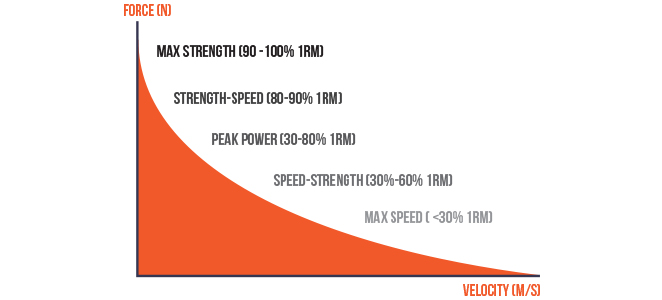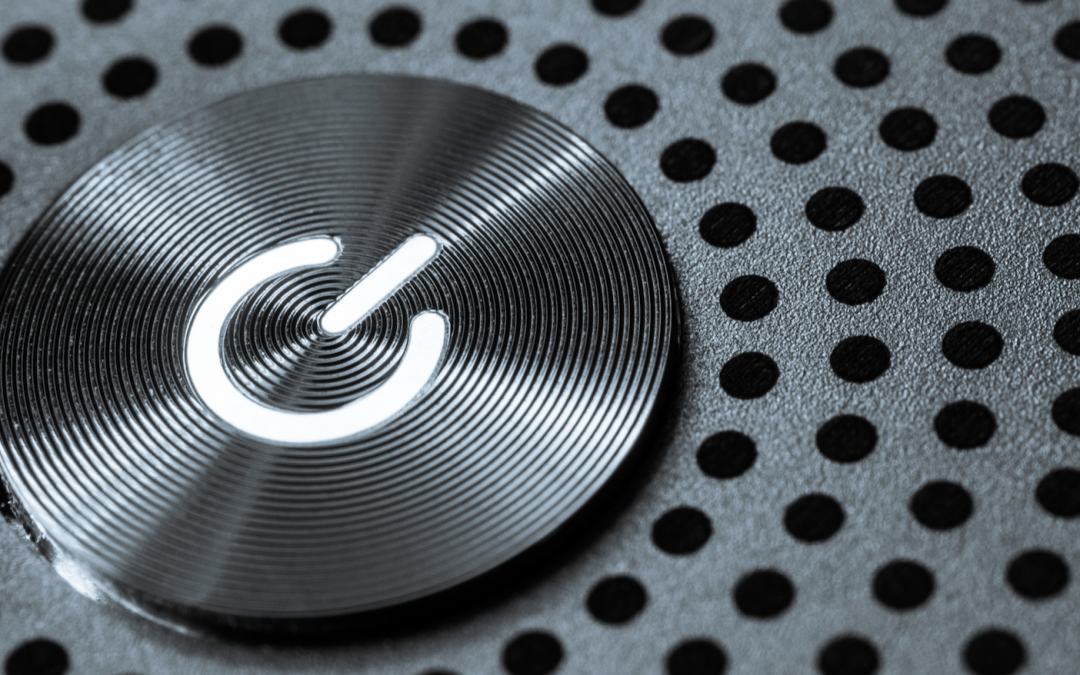One of the most important aspects of training that can be improved in the weight room is power, however all power is not created equal. There are different types of “power” that go by many different names amongst physical preparation coaches and sports scientists, however, I will summarize them into two categories for the sake of simplicity.
Let’s call them reactive ability and power. Reactive ability refers to how well one utilizes stored kinetic energy in their tissues to increase power on the subsequent concentric contraction. This is also called “Fast SSC power” and is indicative of very fast athletes who appear very springy and quick off the ground. You know these athletes when you see them. They may not be the strongest or most powerful athletes, but they have an uncanny ability to get off the ground as quickly as possible because they do such a great job of storing elastic energy in their tissues.

Power refers to how much force one can generate in a short amount of time. There are certainly many different classifications and sub-categories of power along the force-velocity curve, but let’s keep it simple and call it what it is; force divided by time. Powerful athletes are usually much stronger than reactive athletes but they do not necessarily do a great job of storing energy and springing off the ground. Instead they have to rely on purely mechanical energy produced by their muscles to create high levels of power.

Coaches and athletes alike all know that being more powerful can lead to improved sporting performances, but it is important to train in a way that is tailored for the athlete instead of just taking a one size fits all approach to power development. Many coaches and athletes see various power exercises and blindly fit them into an athlete’s program with no consideration of what sporting qualities they are impacting. Instead of starting with the exercises and randomly compiling them into an athlete’s program, we as physical preparation coaches should follow a more intelligent and scientific approach to prescribing plyometric and power training programs for our athletes. This should be one that addresses the specific qualities we feel need to be developed to help the athlete achieve his/her goals.
Here I introduce a 6 step process that we use to help write programs, check our work, and hold ourselves accountable:
Step 1: Identify
- Sport/ Sporting Demands
- Position/Position Demands
We need to start with identifying the sport and sporting demands. For example, a football player’s power needs vary widely from a golfer’s. Additionally, a defensive lineman has very different needs than a cornerback in the context of speed and power demands. Training for a quality that is not needed can at best be an inefficient use of the athlete’s precious training time, and at worst can actually hinder sports performance by interfering with coordination.
Step 2: Assess
- Power
- Different qualities I.e. reactive power vs accelerative power
The next and possibly most important step is to assess your athlete’s power-producing abilities. I do not want to list too many specific tests because there are many options depending on available time and budget. Instead, I will give the principles behind the testing and will give several options that I have used.
The overall theme is that coaches need to be able to distinguish an athlete’s reactive abilities versus their power abilities by comparing a power test (non-continuous jump test) to a reactive test (continuous jump test).
There are many ways to do this. Several middle of the road budget options are the Just Jump Mat and the Push Strength Bands. On the Just Jump mat, you can have an athlete perform a vertical jump test and a 4 jump test to compare one’s power-producing capabilities to their reactive abilities. There are more options available with Push Bands, including three variations of vertical jumps and two measurements of the Reactive Strength Index of the athlete. I highly recommend both options if one has the budget for them.
Both of these options are great, but what can coaches do if they do not have access to such tools? Do they just have to assume an athlete’s results based on what they look like?
Not so fast.
We can still perform the assessments we need without any fancy equipment. A really simple way to do this is to compare an athlete’s triple jump test to their non-continuous jump results. Simply have an athlete perform a standing broad jump. First, see if they can jump their height in inches, and then multiply it by three. Next, have them then perform three continuous broad jumps for distance. If they cannot jump their height in inches, they are not very powerful. If their continuous jumps are very close to their broad jump multiplied by three, then they do not do a very good job of utilizing stored kinetic energy during the SSC and therefore are not very reactive. If their continuous triple jump is much further than their broad jumps with a stick, then reactivity is not a problem for this athlete.
Speed
- Acceleration vs Maximum Velocity
Different components of speed are actually very important to test to determine which plyometric or power exercises to prescribe to athletes. Jumps or plyos can and will improve power production, but perhaps their most important benefit comes from their ability to transfer to certain speed qualities.
Exercises that transfer to the acceleration phase in a sprint will look very different from exercises that will lead to increases in maximum velocity sprinting speed. In the acceleration phase, we want as much force produced as possible during a longer period of time in a more horizontal orientation. During top-end speed, we still want high force but it must be performed as rapidly as possible because ground contact times are much quicker in maximum velocity sprinting.
If technology allows it, you can use a breakdown of splits of a 30 or 40-yard dash to assess an athlete’s speed profile. If their 10 is slow in comparison to their 30 or 40, then they might be more reactive and thus need more acceleration/power specific jumps whereas if their 10 is very good but their 40 time is not where you want it, they might need more reactive plyometric training.
Below are some guidelines for Acceleration power exercises versus maximum velocity exercises:
Acceleration
- Longer eccentric phase or a possible pause
- Greater hip, knee, and ankle displacement
- Non-continuous nature
- Can be performed with load
- More horizontal nature
- Longer ground contact times
Maximum Velocity
- Quick eccentric and amortization phase
- Lesser hip, knee, and ankle displacement
- Stiff ankle
- Continuous nature
- More vertical orientation
- Shorter ground contact times
Step 3: Decide
- Which qualities you want to improve
This part should be simple, but there are several important considerations. The first thing is that power and reactive ability are not mutually exclusive. They are different qualities, so some athletes that are very powerful might not be very reactive and vice versa.
Also, do not just rely on what the testing data tells you your athletes are weak at without considering it in context. For example, a lineman’s reactive ability might be very low when compared to their power, but here is where it’s important to consider both their needs/weaknesses AND the demands of the sport. How often is a lineman reaching maximum velocity in a game? Instead, we should compare our athletes to the norms of their position to see where they fall into place. I expect a marathon runner to have very different power measures than a linebacker, so it would be foolish to decide that a marathoner needs more power if we compared him to strength and power athletes.
I do think power is important for a marathoner, however, we need to compare our athletes to the norms in their sports and positions rather than in totality. The marathoner could look like he needs much more power if we compare him to all athletes, but he could be above average compared to other marathoners and if we just went off the overall data, we would be wasting precious training time that could be spent on more specific training.
Step 4: Prescribe
- The correct progression of exercises
- The correct progression of volume and intensity
It is important to have a systematic way of progressing athletes through various plyometric and jumping exercises. It is essential to build quality jumping and landing mechanics before transitioning to higher level power or plyometric exercises.
Toe drops, box jumps, and hurdle jump with a stick are all excellent options to train jumping proficiency. If power is the goal, these can be progressed to various weighted jumps such as KB Squat Jumps, Med Ball Hug Vertical Jumps, etc. Low-level extensive plyometrics are excellent options to build a base and prepare the tissues for higher levels of reactive drills. Skipping and jump rope are great places to start, but I also love aerobic plyometrics. Often I will start an athlete with one day of hurdle jump with a stick to train landing proficiency and one day of aerobic plyometric hurdle hops to build some low-level elasticity and then slowly blend the two. The first day takes care of the intensity and quality of movement, and the second day prepares the athlete to handle increasingly progressing levels of volume and intensity. The second month could be hurdle jumps with one bounce and some higher volume or intensity aerobic plyos, then the third-month true continuous hurdle jumps on one or both days.
Some coaches shy away from the necessary volumes of plyometric drills because they fear repeated ground contacts can lead to increased risk of injury, but I would argue that shying away from landings can lead to unprepared athletes when they take the field. Also, if we truly want to create the reactive adaptations we desire then we need to build up sufficient levels of volume. 2 days of plyometrics or jumps is a sufficient frequency, and athletes should be built up to around 50-60 contacts per session to improve the qualities we wish to improve.
Step 5: Train and Monitor
- Adjust the program on the fly if needed
One of the best ways to consistently track and measure progress with jumps is to build it into the athlete’s programs.
Training to increase vertical jump and have access to a Jump Mat? Great, just build in Vertical Jumps on the Jump Mat as part of the program and track progress over time. Building the testing into the program kills three birds with one stone.
We get a training effect, we can measure trends in progress over time to make sure we are trending in the right direction, and it gives us an easy way to auto-regulate our athletes. If you’re training to improve power and their vertical jump numbers are way down on one particular day, this may be indicative of an athlete that is highly fatigued and may be unprepared to execute high-intensity or high volumes of training on that day. In this case, consider dropping volume to allow them to recover. I would probably cut volume to about 60% of the planned volume if they were a little run down, or make it an aerobic recovery session if they were way down.
You can also auto-regulate if you’re using the Reactive Strength Index testing to improve reactive abilities. The RSI stiffness test with Push Bands can be used to assess the athlete’s readiness for the day and make modifications as needed just as you would with a vertical jump test.
Step 6: Re-test
- Did the athlete get better in their tests that you were seeking to improve?
- Was there a spillover effect into other tests?
- Did the athlete decrease in other tests?
Re-testing is obvious, but not everyone does it. We need to make sure the program we wrote worked. We should obviously re-rest the specific tests or adaptations that we sought to improve, but we should also re-test other tests to see if there was a spillover effect on other outcomes. Lastly, we should check to make sure we didn’t’ decrease performance in other categories. We can never be too sure.
When should we re-rest? There is no hard and fast rule and logistics will come into play here, but we should give enough time to actually create adaptations. In a perfect world, I would perform a battery of tests every three months. But remember that we can test every session if we build it into the program.
Summary
- Understand power versus reactive ability
- Follow a systematic process to determine if an athlete has greater power or reactive ability
- Write a darn good program to improve either power or reactive ability
- Execute and monitor the program to make sure things are trending in the right direction
- Re-test whatever adaptations you sought to improve to check your own work and make sure the program achieved the desired results!
For more information on training review our blog on our website, or, if you’re interested in being one of our athletes, check out our page on performance training.

